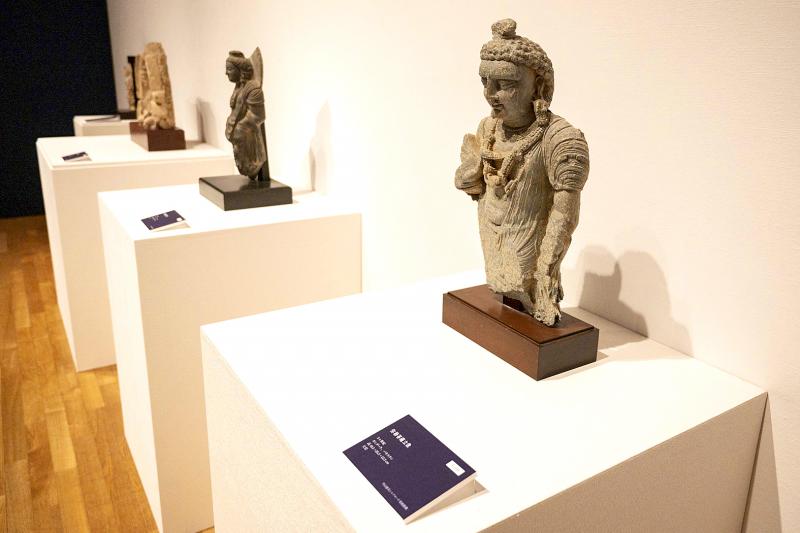Japanese researchers have crafted a “super clone” of an Afghan mural destroyed by the Taliban, using a mix of traditional and digital techniques that they hope would salvage the work’s “spirit” for future generations.
Not a single fragment remains of the seventh-century cave painting demolished in 2001, along with two massive Buddha statues and other artefacts in Afghanistan’s Bamiyan Valley, sparking global condemnation.
However, a precise replica, the result of three years of state-of-the-art reproduction efforts, went on display at a museum in Tokyo in September and last month, just weeks after the Taliban returned to power in Kabul.

Photo: AFP
The mural on the ceiling of a cave near the famous statues depicted a blue Bodhisattva — or someone on the path to becoming a Buddha.
At 6m long and 3m high, the intricate full-size copy has been dubbed a “super clone” by the reproduction team at Tokyo University of the Arts.
“We have succeeded in recreating a very precise representation in three dimensions,” from its texture to the type of paint, team coleader Takashi Inoue said.
The team digitally processed more than 100 photographs taken by Japanese archeologists of the mural before it was desecrated, to create a computerized model of its surface.
They then fed these data into a machine, which carved the exact shape into a Styrofoam block.
To complete the replica, artists applied a traditional paint in a lapis lazuli shade similar to the one used for the original mural.
Through this process, “we can reproduce designs that are very close to the real ones again and again, to hand down their spirit to future generations,” said Inoue, a professor specialized in Eurasian cultural heritage.
For historian Kosaku Maeda, a coleader of the Tokyo reproduction team, the “massively shocking” images of the giant Buddhas disappearing into clouds of dust are still a vivid memory.
“I was worried that such an act would be inflicted on the remains once again,” said the 88-year-old, who has visited the valley repeatedly over more than 50 years.
However, their work shows that vandalism is “meaningless” in the face of modern technology, as “everything can be digitalized,” Maeda added.

BOMBARDMENT: Moscow sent more than 440 drones and 32 missiles, Volodymyr Zelenskiy said, in ‘one of the most terrifying strikes’ on the capital in recent months A nighttime Russian missile and drone bombardment of Ukraine killed at least 15 people and injured 116 while they slept in their homes, local officials said yesterday, with the main barrage centering on the capital, Kyiv. Kyiv City Military Administration head Tymur Tkachenko said 14 people were killed and 99 were injured as explosions echoed across the city for hours during the night. The bombardment demolished a nine-story residential building, destroying dozens of apartments. Emergency workers were at the scene to rescue people from under the rubble. Russia flung more than 440 drones and 32 missiles at Ukraine, Ukrainian President Volodymyr Zelenskiy

COMPETITION: The US and Russia make up about 90 percent of the world stockpile and are adding new versions, while China’s nuclear force is steadily rising, SIPRI said Most of the world’s nuclear-armed states continued to modernize their arsenals last year, setting the stage for a new nuclear arms race, the Stockholm International Peace Research Institute (SIPRI) said yesterday. Nuclear powers including the US and Russia — which account for about 90 percent of the world’s stockpile — had spent time last year “upgrading existing weapons and adding newer versions,” researchers said. Since the end of the Cold War, old warheads have generally been dismantled quicker than new ones have been deployed, resulting in a decrease in the overall number of warheads. However, SIPRI said that the trend was likely

‘SHORTSIGHTED’: Using aid as leverage is punitive, would not be regarded well among Pacific Island nations and would further open the door for China, an academic said New Zealand has suspended millions of dollars in budget funding to the Cook Islands, it said yesterday, as the relationship between the two constitutionally linked countries continues to deteriorate amid the island group’s deepening ties with China. A spokesperson for New Zealand Minister of Foreign Affairs Winston Peters said in a statement that New Zealand early this month decided to suspend payment of NZ$18.2 million (US$11 million) in core sector support funding for this year and next year as it “relies on a high trust bilateral relationship.” New Zealand and Australia have become increasingly cautious about China’s growing presence in the Pacific

Indonesia’s Mount Lewotobi Laki-Laki yesterday erupted again with giant ash and smoke plumes after forcing evacuations of villages and flight cancelations, including to and from the resort island of Bali. Several eruptions sent ash up to 5km into the sky on Tuesday evening to yesterday afternoon. An eruption on Tuesday afternoon sent thick, gray clouds 10km into the sky that expanded into a mushroom-shaped ash cloud visible as much as 150km kilometers away. The eruption alert was raised on Tuesday to the highest level and the danger zone where people are recommended to leave was expanded to 8km from the crater. Officers also